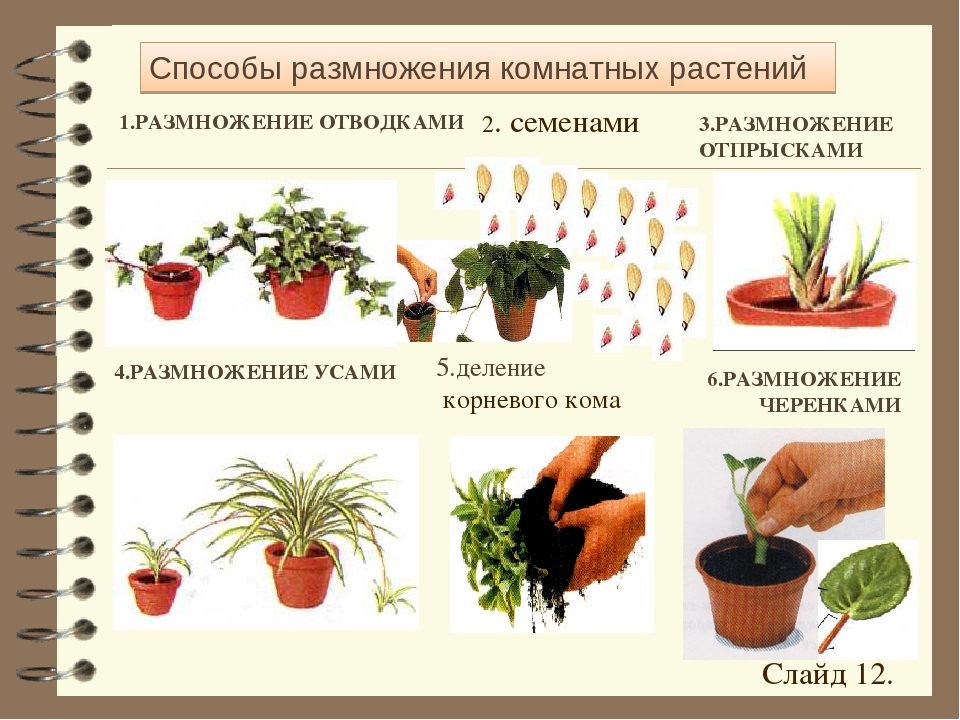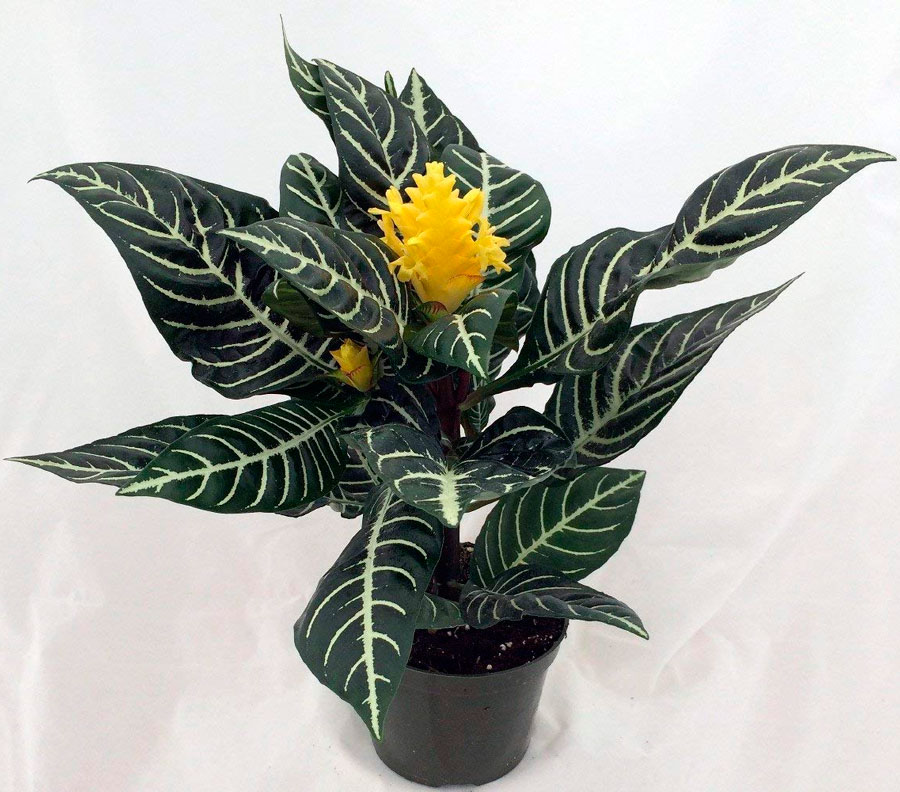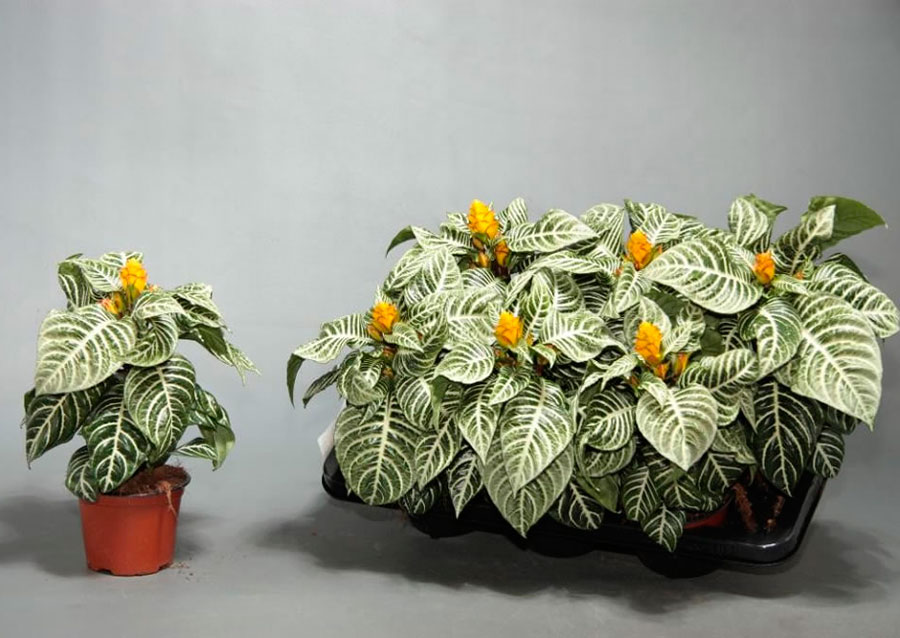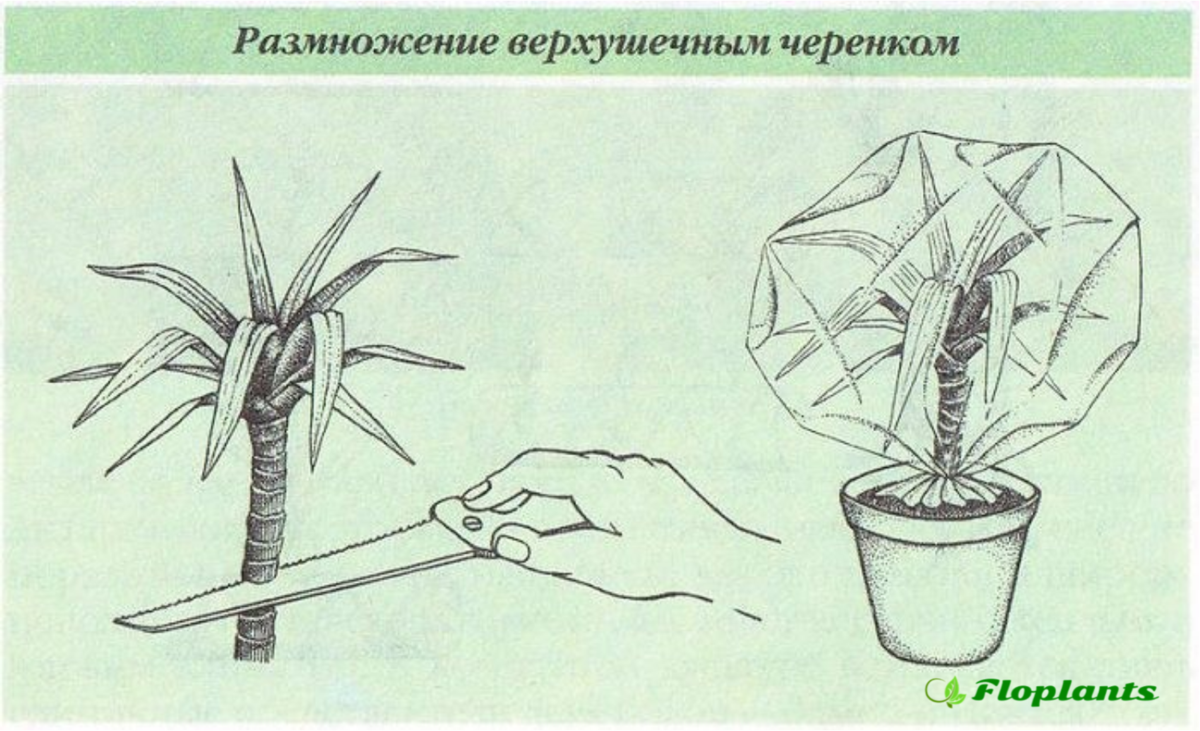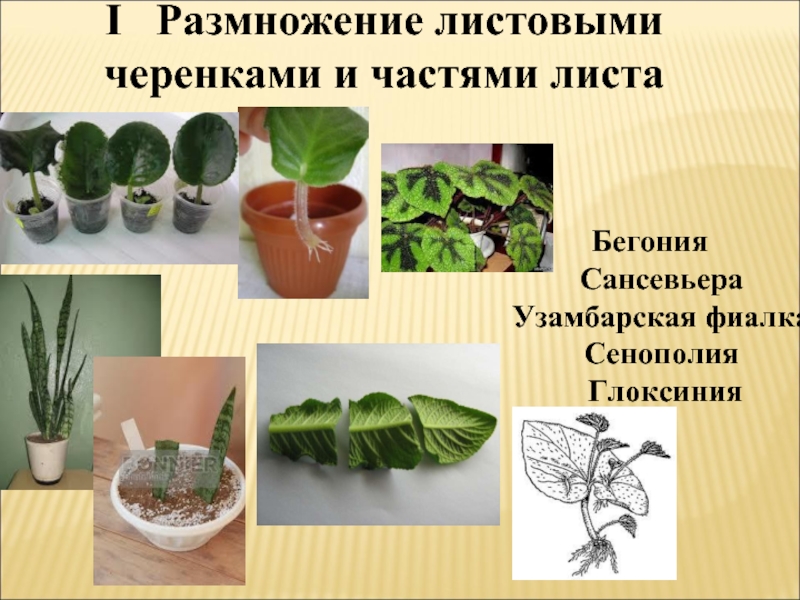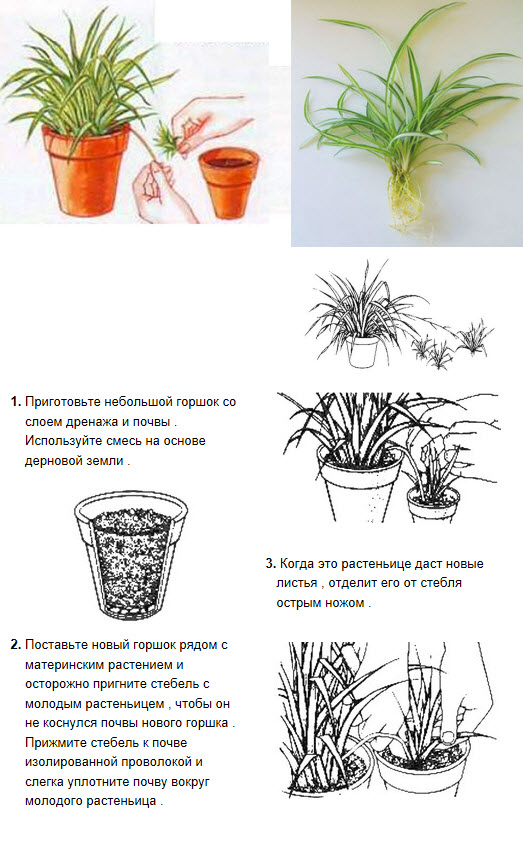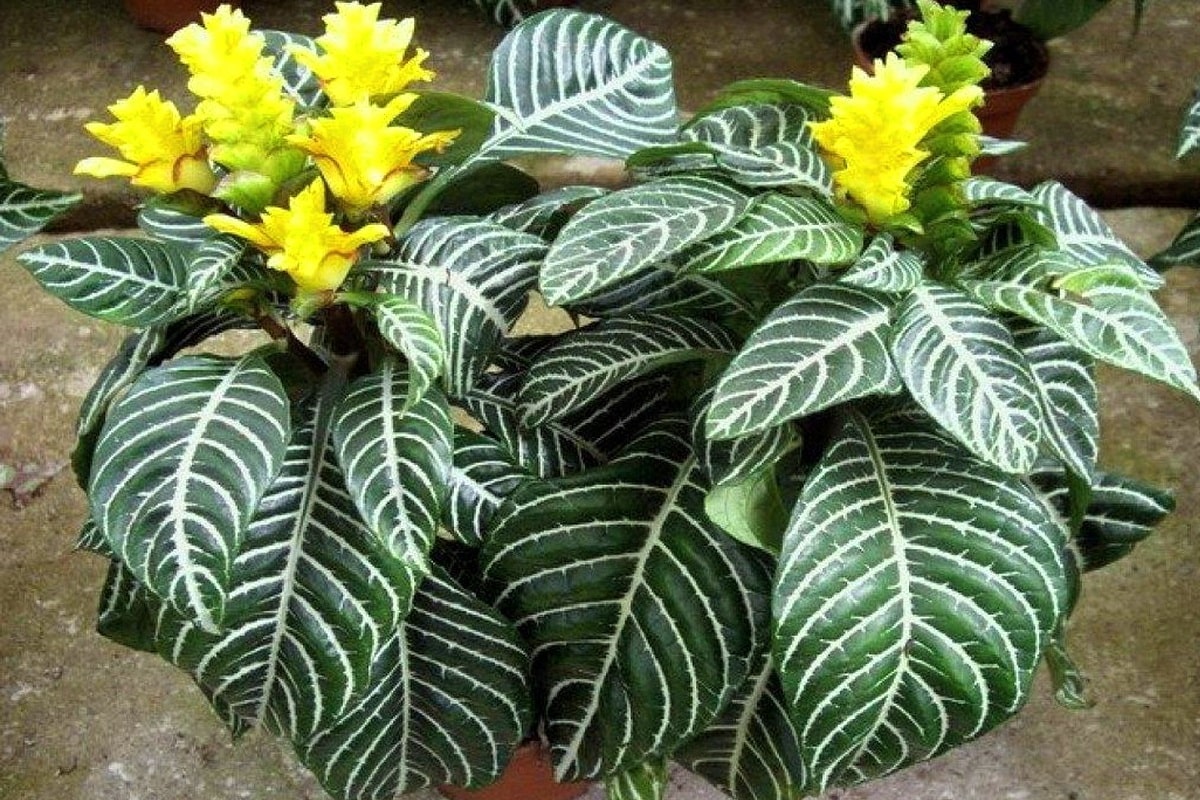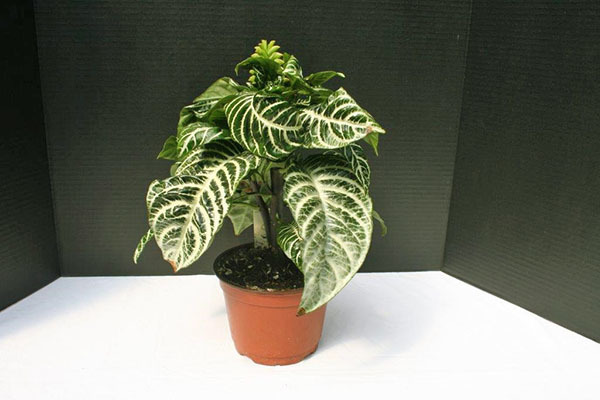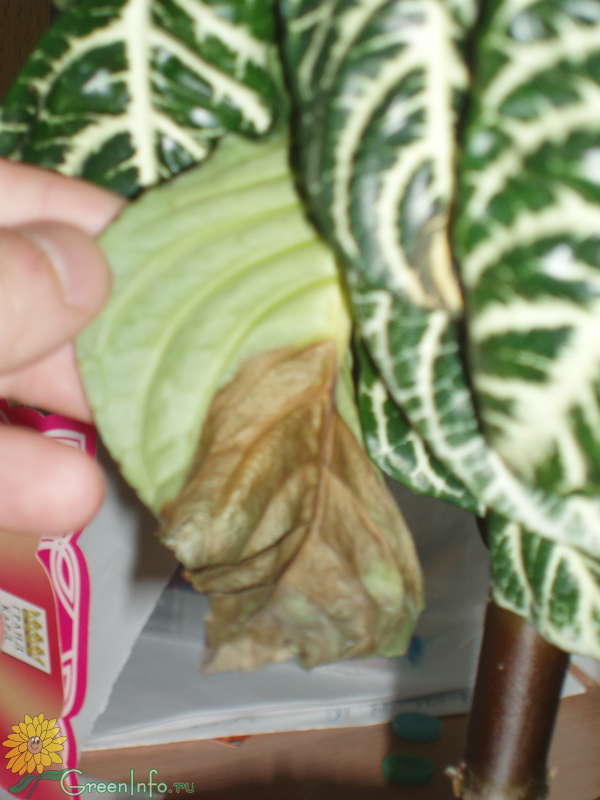Problem solving
Problems with afelandra usually begin with improper care. They can manifest themselves in different ways, but if you do not respond to the sos signals, the flower will die very quickly.

This Afelandra was most likely kept in a cold draft.
So, the main thing is to diagnose the cause of the deterioration in time and correct the shortcomings.
Care errors and their elimination - table
| Problem | Cause | Elimination |
| Falling leaves | Insufficient watering | Adjust watering mode |
| Draft or low room temperature | Move to a warm place without drafts | |
| Plenty of bright sunlight | Cover or remove the plant from direct sunlight | |
| Lack of nutrients in the soil | Adjust the feeding mode | |
| Dry air | Spray the leaves every day, place the pot on a pallet with damp drainage | |
| Plant wilting | Cold draft | Rearrange the flower to a different location |
| Brown leaf edge | Mold damage | Remove the infected leaves, treat the plant with a fungicide according to the instructions |
| Insufficient moisture | Spray the leaves every day, place the pot on a pallet with wet sawdust | |
| Brown spots | Excessive amounts of bright sun | Ventilate the room regularly or change location |
| Lack of fresh air | Shade or rearrange the plant | |
| Shrinking leaves | Lack of minerals | Adjust the feeding mode |
| Pot too tight | Transplant into a larger pot |
Due to its poisonous juice, this flower rarely gets sick, but waterlogging is destructive for it: fungal diseases - rot can develop. In addition, a plant weakened by improper care loses its immunity and is easily affected by pests.
Diseases and pests of Afelandra - table
| Source of defeat | Signs of the disease | Prophylaxis | Treatment |
| Shield | Brown plaques and sticky drops on the leaf plate | Regular inspection and wiping of leaves with a damp cloth | One-time or weekly (in case of severe infection) treatment with chemicals Fitoverm or Actellik |
| Falling leaves | |||
| Mealybug | Whitish bloom on the leaves in the form of cotton wool | Wiping with soapy water followed by insecticide treatment | |
| Aphid | Deformed tips of the sheet plate | Treatment with Akarin, Iskra Bio preparations or infusions of plants with a pungent odor, such as wormwood | |
| Dying leaves | |||
| Insect colonies on leaves | |||
| Root rot | Roots darkened and softened |
|
Surgical. Cut off the affected parts of the root system (if all the roots are affected, the plant can no longer be saved), rinse the remaining roots, sprinkle the cuts with crushed coal and after a couple of hours transplant the flower into a new disinfected soil with good drainage. |
| Leaves gradually turn yellow and wither |
Features of growing and caring for a plant
To successfully grow afelandra, it is necessary to create tropical conditions: high air temperature, a lot of moisture, no drafts.
Watering features
In the summer, it is important to ensure that the soil in the flower pot is constantly moist, and in the fall and winter it dries out slightly between waterings. If the soil is too dry or too moist, the plant can quickly wither and discard its leaves.
If the soil is too dry or too moist, the plant can quickly wither and discard its leaves.
Lighting features
The best development of Afelandra is observed in well-lit windows or in greenhouses.
But, it is important to protect the plant from direct sunlight.
The flower also grows well on eastern and western windowsills. In summer, flowers on the southern windows must be shaded from 11 to 17 hours
It is also important to protect Afelandra from drafts.
We provide the right moisture
To maintain the correct humidity in the room, it is recommended to artificially humidify the air using:
- spraying, which is carried out in summer in sunny weather;
- a household humidifier used only in winter;
- a container with water, which is also used in winter to provide a long-lasting moisturizing effect.
Moistening the soil and air in the room, it is important not to overdo it, so as not to provoke rotting and death of the plant
The right choice of soil

The soil for planting Afelandra should be loose and fibrous. An earthen mixture can consist of the following components:
- leafy land mixed with sand and peat in the same amount;
- brown peat mixed with moss, sand and leafy soil. Also, crushed coal and 30 grams of superphosphate must be added to the soil;
- foliage of earth mixed with humus, moss and vermiculite, coal and 30 grams of bone meal;
- mix the foliage of the earth with turf, peat, charcoal and needles, vermiculite;
- sod land mixed with coniferous soil, peat, vermiculite, moss and humus.
The selected earthen mixture must be sterilized before use.
We fertilize and feed correctly
Home care for Afelandra consists in applying a large amount of mineral and organic fertilizers. They are applied together with water every two to three times of watering. Adjustment of the amount and composition of the applied dressings is carried out taking into account the growth and development of the plant.
With a lack of nitrogen, the leaves of the flower turn yellow. And with its excessive application, buds cannot be set.
With a lack of phosphorus, the inflorescences become small and dull, and with a lack of potassium, leaves begin to fall off or yellow or brown spots form on them.
Temperature rules
During the day, the air temperature in the room should be no higher than 27 degrees Celsius, and at night - not lower than 18 degrees. Some varieties of Afelandra can withstand air temperatures of 13 degrees Celsius.
Keeping the air fresh is important, so ventilate the room as often as possible. In order for the protruding aphelandra to bloom faster and form buds, it is recommended to grow it for 60 days in a room with an air temperature of 13-15 degrees Celsius.
Transplant features
Every year within three years after planting the plant, it must be repotted. Adult afelandras are transplanted every four years. The transplant is carried out into the soil created with his own hand.
Pruning features
To obtain the splendor of the bush, pinch the young plant. To do this, the buds must be removed from the upper shoots. The procedure is carried out every year, in February, before the growing season. In order for the plant to successfully endure the pinching, it is recommended to spray it well after the procedure and cover it with cellophane.
If the afelandra at home often begins to throw back the leaves, in order to preserve its decorative effect, it is recommended to cut the stalk, root it and grow a new young plant.
Protection from pests and diseases
If you take care of the aphelandra incorrectly, it will be attacked by scale insects, aphids, mealybugs. To protect the plant, wash it with soapy water and spray it with insecticide.
Roots often darken and become soft due to root rot. The defeat is indicated by yellowing and wilting leaves. To eliminate rot from the roots, cut off the heavily affected parts, and rinse those that are less affected and sprinkle with chopped coal. After a few hours, transplant the flower into a new pot with good drainage at the bottom.
As a preventive measure against root rot, water the plant sufficiently, without excessive moisture.After the flower has absorbed the amount of water it needs, drain the remaining liquid from the pan located under the pot.
Solving common problems
When growing aphelandra, you often have to face various problems. Most often they arise from improper care or inappropriate growing conditions.
Care errors
Aphelyandra belongs to capricious plants, therefore, with the slightest mistakes, problems immediately begin. Leaves may wilt, become small or brown in color.
Withering
One of the common problems when growing a flower is wilting of foliage and stipules. If only the tips of the leaves began to fade, it means that the flower is in a room where the air is too dry. It is necessary to spray the leaves as often as possible and remove the pot away from heating appliances. If the leaves wither completely, it means that the plant is standing in a draft or it does not have enough moisture. It is especially dangerous to open windows in the evenings after watering. Because of this, the flower may die. Incorrectly organized watering, the constant presence of a flower in the sun and a draft is to blame for the fall of the foliage.
Brown leaf edges
The edges of the leaves turn brown due to too dry air in the room in which the flower is located. In order to prevent this problem, the leaves should be regularly sprayed and wet rags should be placed on the batteries during the heating season.
Brown spots
The appearance of brown spots on aphelandra leaves indicates that the plant is exposed to too much direct sunlight. In order for the flower to stop appearing brown spots on the foliage, it must be rearranged in partial shade.

Shrinking leaves
If it becomes noticeable that the foliage is becoming shallow, then the reason is a lack of nutrients in the soil. It is necessary to introduce mineral and organic substances into the soil more often. It may also be due to a lack of nutrients in the soil.
Pests
Often you have to deal with pests that can appear on the plant for various reasons.
Mealybug
The first signs of the appearance of a mealybug are twisting and falling of foliage, the plant itself stops growing. If there are a lot of pests, white lumps begin to appear on the foliage. In order to get rid of the worm, you need to treat the plant with Actellik. First, the leaves must be rinsed under the shower to wash off some of the insects. This procedure can be repeated several times.
Aphid
Aphids usually appear on the underside of the leaves. Insects feed on sap, which causes the leaves to dry out and fall off. In this case, the drug "Actellik" and rinsing the foliage under a warm shower will also help. Spraying with soapy water helps from aphids.
Shield
If small brown or reddish-brown bumps appear on the leaves, then this is a scale insect. Sometimes the bumps can be green or yellow. They can be located both on the inside and on the outside next to the veins. The leaves themselves become sticky to the touch. As soon as insects begin to appear on the foliage, the plant must be immediately sprayed with insecticides. Mechanical cleaning will also help. For example, you can use a soft-bristled toothbrush to brush off the scabbards.
Diseases
Various diseases are another problem that has to be faced when growing.

Most often, aphelandra suffers from the following diseases:
- corynespora fungus;
- leaf spot;
- root rot.
With the corinespore fungus, brown or yellow spots appear on the foliage. The leaves begin to dry out, then die off. Plants are treated with fungicides three times a week. All affected leaves and stems are pruned. When spotted, yellow or brown wet spots appear. They are often covered with mucous secretions. Spraying with fungicides three times a day helps with this disease.
With root rot, there are no signs, the plant simply begins to wilt for no reason. All damaged parts of the root system must be cut off. Sprinkle the slices with charcoal. Then the plant is transplanted into new soil and watered with "Fitosporin".
Description and types of tropical plants
 The flower belongs to the Acanthus family. This is a tropical evergreen plant with bright green rigid leaves of a rounded-oblong shape with a pointed end. Some varieties have silvery or cream streaks on the leaves. In natural conditions, the habitat of Afelandra is Central and South America.
The flower belongs to the Acanthus family. This is a tropical evergreen plant with bright green rigid leaves of a rounded-oblong shape with a pointed end. Some varieties have silvery or cream streaks on the leaves. In natural conditions, the habitat of Afelandra is Central and South America.
Although the shrub is considered a stunted plant, at home it can grow up to two meters, which must be taken into account when planting. Plant it in a large flowerpot and prune it regularly to prevent the aphelandra from burying itself in the ceiling.
This tropical shrub is appreciated primarily for its unusual type of buds. The inflorescences are collected in a kind of spikelets or small cones. Usually they are red in color, sometimes they can be painted in lilac. Since Afelandra is a tropical plant, it also needs to create an appropriate microclimate at home.
In nature, there are about one hundred and fifty varieties of this plant, but only a few of them have firmly settled in our apartments. The following types of Afelandra are grown at home:
- Afelandre Retzl. The species is very popular among gardeners due to its large, beautifully shaped white-silver leaves. Long (about 15 cm) inflorescences consist of bright red flowers. At the end of the flowering period, the plant forms fruits with seeds, which, after ripening, can be used for home breeding of Afelandra.
- Afelandra golden (orange). The homeland of the flower is Mexico. It is a stunted shrub with a thick reddish stem. Its smooth green leaves with a silvery bloom reach a length of about 25 cm, are ovoid. The inflorescence in the form of a tetrahedral spike reaches a height of 15 cm. Green bracts are located around the flowers of a bright orange hue. Flowering lasts 6-7 days.
- Afelandra protruding or skuarros. It is the most common type in home floriculture. This is a short shrub with bare succulent shoots of a reddish tint. The leaves are dark green with white veins, rather large (up to 30 cm), ovoid. Light yellow flowers with orange bracts are collected in long tetrahedral inflorescences.
The main types of Afelandra




Diseases and pests
As a rule, Afelandra is not affected by diseases, most often those who grow Afelandra at home have to deal with aphids and spider mites.
How to recognize and control aphids
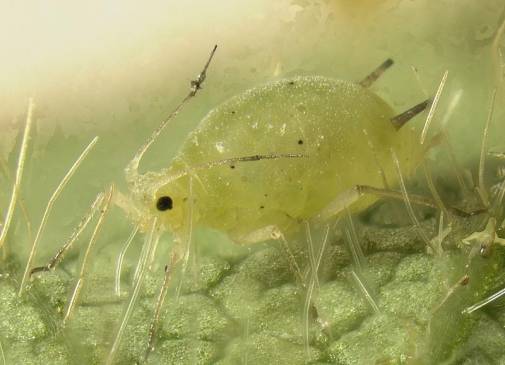
Aphid colony can destroy a houseplant in a matter of days.
It is quite problematic not to notice aphids. The lower part of the leaves is covered with pests that settle in whole colonies and suck the juice out of the plant. The most popular with aphids are the upper, more delicate leaves and inflorescences. The smallest brownish dots are clearly visible in the lumen - dead areas of plant tissue. An additional symptom is sticky transparent discharge. If left untreated, the leaves will turn yellow, deform and fall off.
It is much easier to deal with aphids detected in time than with most pests of indoor plants. A soft toothbrush, a cotton pad is moistened in a thick foam of household or green potassium soap and washed off with aphids. Then Afelandre is given a warm (+ 35… + 40 ºС) shower and the plant is dried.
To consolidate the result, you can use folk remedies. Their effectiveness is due to the fact that aphids do not like strong odors. The finished infusion is filtered and sprayed with plants, not forgetting about the pot and the pallet. The recipes are as follows:
- 2-3 tablespoons of finely chopped onions, garlic or garlic arrows, tomato tops are poured with a liter of warm water, insisted for 2-3 days.
- Blooming celandine, marigolds, wormwood, dandelion leaves and roots (250-300 g) are cut, boiled in a water bath for half an hour, cooled to room temperature.
- Dried peels of 1-2 citrus fruits are poured with a liter of boiling water, insisted for 3 days.
- Dry leaves of self-grown tobacco or hot pepper pods (40-60 g) are crushed, insisted in a liter of water for a day. The same amount of water is added before use.
If time is lost, and aphids have multiplied, insecticides are used strictly according to the instructions. The best results are given by Fitoverm, Strela, Kinmiks, Inta-Vir, Arrivo, Fury, Karbofos. It is necessary to carry out 3-4 procedures with an interval of 7-10 days, each time changing the preparations.
How to get rid of spider mites
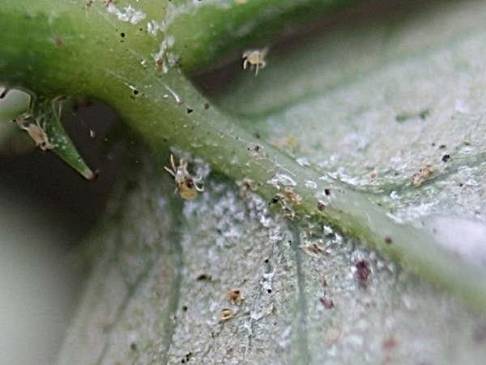
High air humidity - not only comfortable for Afelandra, but also an effective prevention of spider mites
The presence of spider mites in a pot with aphelandra is evidenced by thin, almost transparent filaments intertwining the leaves, and whitish dots on the lower part of the leaf plate. If you do not pay attention to these signals, the flower will soon disappear under a continuous layer of a whitish mass, similar to a cobweb. The pests will stop hiding and form a continuous wiggling carpet on the tops of the shoots and the ends of the leaves.
The best breeding environment for spider mites is dry air. Therefore, spraying, vital to Afelandre, is an excellent prevention of pests. But "bathing" the plant will not help. Ticks are able to form a protective air shell around themselves.
They also hate ultraviolet light. Get a lamp, irradiate the plants every 10-15 days.
If you find pests, immediately isolate the flower. Wipe the pot, tray, and window sill area with rubbing alcohol. Wash Afelandro with soap. Wipe off the foam, water the plant abundantly, put a plastic bag on top and fix it securely. Remove after three days.
At the initial stage of the lesion, infusions of onions or garlic help. Arrows, husks, finely chopped cloves and onions (about 25-30 g) are poured with a liter of warm water, tightly closed and infused for 3-5 days in a dark, warm place. Strain before use, then spray flowers and soil.
If you have raw materials, you can prepare a decoction of cyclamen tubers. They are cut into 3-4 parts, boiled for 35-40 minutes, removed from heat. In a day, the broth is ready for use.
Home care
Afelandra is a very demanding plant to care for, growing it is difficult. Under artificial conditions, it grows best in humid, warm, well-lit greenhouses. Caring for a flower involves following these rules.
Lighting. Despite the fact that this is a very light-loving plant, it must be shaded from direct sunlight.
The best source of daylight is windows on the west or east side of the room. In the summer in the middle of the day, the windows should be slightly shaded. At this time, it is better to take the plant out into the open air, but do not allow precipitation to fall on it and protect it from drafts. If it is constantly in the room, then regular ventilation is necessary.
In winter, window shading is not required, but the lighting of the place should be maximum. For this, fluorescent lamps are placed directly above the plant at a distance of no more than a meter. The duration of illumination should be at least 8 hours a day. In case of a lack of light, it stretches out and in most cases does not bloom.
Temperature. By nature, this is a tropical plant, and the minimum temperature of the place of growth should be at least 20 ° C. The optimum temperature of the content is 22-26 ° C. And only for the protruding aphelandra, the temperature for flowering can be lowered to 10 ° C.
Watering and humidity of the environment.The plant requires abundant watering in the summer, but the substrate should not be waterlogged. Waterlogging, as well as desiccation, is destructive. From autumn to spring, watering should be reduced, but only so that the ground is not dry, and water should be avoided on the plant.
The flower feels great with frequent spraying from a fine spray, and it is better to install a humidifier in the room.
Fertilizer. In the summer, the plant requires feeding. It can be organic or mineral fertilizers of normal concentration.
Pruning. To make the aphelandra grow into a lush bush, pinch the young plant. For this, the buds are removed from the upper shoots. This is done annually, before the growing season in February. For better adaptation, after this procedure, the bush should be well sprayed and put on a transparent plastic bag.
Advice! It happens that the leaves of a plant fall off, and it loses its decorative effect.
Home care
Such a whimsical flower like Afelandra must be carefully looked after. It is better not to put other flowers next to him - he does not like the neighborhood. The plant is transplanted every year, a nutritious soil for transplanting is selected, properly watered and fertilized.

Watering
In hot weather, the plant requires more frequent watering - the soil should not be allowed to dry out or waterlogged. Usually in the summer you have to water the plant every other day. In winter, watering is carried out less frequently (once a week) and not so abundantly, but the ground should always be moistened.
Important! The water must be soft and at room temperature. It is necessary to water at the root, avoiding the ingress of water on the foliage .. For irrigation, it is best to use rainwater or thawed water, but you can also use cooled boiled tap water from a kettle
For irrigation, it is best to use rainwater or thawed water, but you can also use cooled boiled tap water from a kettle.
Top dressing
A fast-growing flower like Afelandra requires fertilization at least 1 time per month, but from March to November - every 2 weeks.
The following fertilizers are suitable for feeding:
- Bona Forte;
- Agricola;
- Baikal EM-1;
- Energen.
After purchasing or transplanting this capricious flower, it is recommended to feed it with Bona Forte Adaptation, as it contains all the substances that help the plant overcome the stress of change.
Pruning
Afelandra is growing rapidly and needs frequent updates. This plant can be updated by pruning, shortening the shoots to 25 cm - it helps to maintain its compactness and decorative effect, and helps to increase the number of peduncles. This procedure is carried out in late winter or early spring, shortly before the start of the growing season. The cut plant is then sprayed and a sachet is placed over it to maintain proper moisture, or the spraying is repeated frequently.
Important! If the plants are not cut, they will stretch out and turn into bushes with bare stems.
Transfer
To maintain a beautiful aesthetic appearance, young aphelandras are transplanted every year. Plants that are more than 3 years old are transplanted once every 3-4 years. The process itself is recommended to be carried out in early spring.

You can buy soil for transplanting indoor plants with an acidity of 5.5–6.5 Ph, but it is not difficult to prepare it with your own hands.
To do this, you can make the following mixtures:
- sod soil from the garden plot, dry peat and coarse river sand in a ratio of 2/1/1;
- soil for flowering indoor plants, dry peat and coarse river sand in a ratio of 6/3/2;
- turf, coarse sand, dry peat, humus (4/1/1).
When transplanting, the pot should be taken 6-7 cm larger in diameter than the indoor flower itself, and be sure with sufficient drainage hole... It is best if it is made of unglazed ceramic.
We recommend reading in more detail how to properly plant indoor flowers in a pot.
When carrying out a transplant, you must adhere to the following recommendations:
- First, pour abundantly the indoor flower.
- After 4-5 minutes, when the soil absorbs moisture well, carefully remove the plant from the pot. Then rinse under running tap water.
- The root system should be examined. Dried, spoiled and broken roots are cut at an angle of about 45 ° with a knife, which is pre-washed for disinfection with a manganese solution.
- The cut must be treated with activated black carbon powder.
- At the bottom of the container for planting, you need to place drainage with a layer of 3-5 cm from expanded clay, pebbles or rubble.
- Cover the pot 1/3 with the prepared soil and place the aphelandra vertically in it, taking care not to damage the roots.
- Cover the plant with soil and tamp it gently. The soil should not reach the edge of the pot by 1.5-2 cm.
- Water the houseplant and put it in the place chosen for it.
General information
In nature, the Afelandra plant grows in the form of a shrub and semi-bush. It can reach a height of about 2 meters. Leaves are large, smooth, glossy. The shape of the leaves is round, but with a pointed tip. Matte, thorny and glossy leaves can be found depending on the species.
The shade of the leaves is rich and catchy. A bronze or light stripe stands out along the dark green leaf and is obtained in the form of a pattern.
Inflorescences reach a height of about 15 cm, there are bright orange, yellow or scarlet. The corolla at the inflorescence has two pairs of stamens and a pistil. The corolla can be purple, scarlet, orange or sunny.
Afelandra flower pleases with its flowering for more than two months. After flowering, a seed box appears, divided into two halves. Each of the halves contains two seeds.

Home care for Afelandra
How to properly care for Afelandra. Afelandra is very moody and demanding on light and humidity, so it will take an effort to grow it.
Lighting and location
The plant needs constant bright light. Direct sunlight can cause burns on the leaves, so shading is required in the daytime. In autumn and winter, when there is not enough sunlight, additional illumination with a fluorescent lamp is required daily for 8-9 hours.
Temperature
The temperature graph of Afelandra can be conditionally divided into several periods, when a certain temperature should be maintained in the room:
- from tying buds to opening them, the temperature in the room should be at least 22 degrees;
- during the flowering period - the temperature should not exceed 24 degrees;
- at the end of flowering - no more than 14 degrees.
The plant needs fresh air, but is afraid of drafts
Reproduction
At home, Afelandra is propagated using cuttings and seeds.
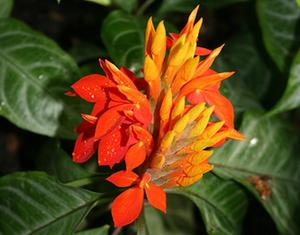
Propagation by cuttings is easy. Most of the planted shoots are viable and take root quickly enough. For rooting, it is recommended to take shoots up to 15 centimeters long with 2-3 leaves. The shoot is separated with a sharp knife or pruner. After it dries slightly, it must be treated with a growth stimulant, charcoal or cinnamon powder - this will protect the plant from fungus and rot.
Young shoots are planted in a mixture of turf and coarse sand and covered with a jar on top. The plant will stay in the greenhouse until it takes root. Rooting takes place within 3-4 weeks.
Shoots should be provided with diffused lighting and high humidity. To avoid rotting, the cuttings are treated with a fungicidal solution.
After rooting, young shoots are transplanted into separate pots with potting soil, as for adult plants.
The propagation of aphelandra by seeds is carried out in the fall, when boxes with seeds are formed on the shrub after flowering.
Seeds are planted in containers with loose, moist soil and covered with foil or glass. It is necessary to maintain a constant temperature of up to 22 degrees and a constant high humidity. After the appearance of real leaves, the plants should be dived and planted in separate pots.
Watering plants and moisture
In natural conditions, Afelandra grows in tropical forests. At home, you need to ensure that the earthen lump is not very waterlogged. Watering is done abundantly, but as needed. During the dormant period, the plant should be watered no more than once a week. The water should be at room temperature.
Spraying is carried out every 2-3 days. After blooming the buds, the spraying is reduced to once a week. This will extend the flowering time of the shrub. In winter, when the air in the room is dry, the pots can be placed on pallets with moistened expanded clay, small pebbles or moss.
Transplanting Afelandra and soil
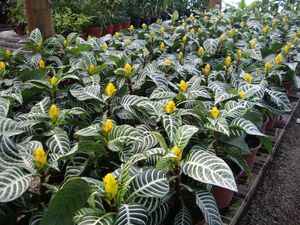
Young plants are transplanted annually
For transplantation, you can use ready-made universal soil or prepare it yourself. For this, leaf and sod soil, peat, coarse sand, fine charcoal should be used in equal parts.
The soil should be light, loose, moisture and air permeable. Before using the potting mix, it is advisable to disinfect it by calcining it in the oven or spilling it with boiling water.
Recommendations for the care and cultivation of Afelandra at home
Temperature regime
The indoor flower Afelandra is considered a capricious plant. In order to grow this handsome man at home, you will have to protect him from drafts and follow all the rules of maintenance.
When caring for a flower, it is advisable to adhere to a certain temperature regime:
- in winter, the minimum temperature should be 15–16 ° С;
- in the spring, the optimal temperature of the content is 20 ° C;
- in summer, the optimal temperature of the content is considered to be 22-25 ° С;
- in autumn it is recommended to keep the plant at a temperature of 18–20 ° С.
Watering and feeding
Caring for a flower at home involves regular abundant watering and constant fertilization. In this case, it is necessary to ensure that the water does not stagnate, since this can cause root rot. In summer, the soil should be well moistened. In winter, watering Afelandra is recommended as the land dries up. You also need to regularly spray the leaves.
A feature of Afelandra is considered to be active growth. Therefore, flower growers are advised to regularly apply fertilizers. For this, mineral complexes are used, which are introduced during active growth and during the growing season. With the onset of cold weather, Afelandru still continues to be fertilized, but much less often. For these purposes, it is recommended to use fertilizers containing potassium, phosphorus and nitrogen.
ADVICE during the active growth of afelandra, it is advisable to use a complex of fertilizers for ornamental deciduous plants, and during flowering - for decorative flowering.
Leaving during flowering and rest
At home, the bulging aphelandra blooms in summer. Inflorescences usually delight with their beauty for several weeks. After that, it is advisable to remove them. If this is not done, then the flower will begin to bear fruit. After the appearance of the fruits of the aphelandra, it may die. In order for the flower to bloom regularly, it is recommended to alternate flowering periods with a dormant period.

Afelandra flower
Immediately after flowering, Afelandra begins a dormant period. How to take care of her during this period? Everything is very simple. From about mid-autumn to early spring, it is recommended to keep a flowerpot with a flower in a bright place. The recommended temperature in this case should be 16–20 ° С. It is also necessary to periodically spray the leaves. Watering the flower at home is recommended as the soil dries out. In the spring, the bottlenose dolphin is moved back to its permanent place.
Pruning
In order for the flower not to lose its aesthetic appearance, it is recommended to cut it periodically. You can form a lush bush with a neat crown by pinching the buds on the upper shoots of a young plant. In adult flowers, trimming of excess shoots is carried out in early spring. During this process, usually up to half the length of the stems is removed. After the excess shoots have been removed, the intensity of spraying the leaves must be increased. This is the essence of caring for a flower at home.
How to transplant a plant
Afelandra care also includes replanting regularly. It is advisable to replant adult shrubs every 2-3 years, and one transplanting in early spring will be enough for young shrubs.
In order to transplant afelandra at home, you need to purchase a high capacity, which is 5-7 cm larger than the previous one. For this indoor shrub, it is advisable to choose pots made from uncoated ceramics. There must be a drainage hole at the bottom of the flowerpot.
For Afelandra, it is better to choose lightweight, loose soil that allows air to pass through well. To make a substrate suitable for its composition, you can purchase a universal and peat soil. Further, sand or fine perlite is added to the purchased land. If the substrate is made independently, then you can also take sod land, dry peat and river sand. All these ingredients are mixed in a 2: 1: 1 ratio.
ADVICEbefore planting afelandra at home, it is advisable to disinfect the soil. For these purposes, you can pour boiling water over it or bake it in the oven for 5 minutes.
Plant transplant and subsequent home care should be carried out according to a certain scheme:
Home care
Lighting. First you need to choose a good place for a flower. He loves dim sunlight, so it is best placed on an east or west windowsill. During maximum solar activity, the plant shades.
In winter, it is also important to keep an eye on the lighting and provide the plant with extra light. The optimal number of hours of flower lighting will be at least nine.
Air temperature
Since the plant is native to warm countries, it always needs warmth. At any time of the year, try to keep the temperature around twenty to twenty-five degrees. In the summertime, Afelandru should be taken out into the fresh air. If this is not possible, then it is necessary to ventilate so that the flower always has an influx of fresh air, but beware of drafts.
Watering. Afelandra requires abundant watering, but do it so that moisture does not stagnate in the soil. If excess water appears in the pan after you watered the plant, drain it immediately. Watering is worth every few days. In winter, it is worthwhile to slightly revise the irrigation regime.
The soil. One of the main points is the correct soil. It should be good air permeability and be loose. What the mixture should consist of:
sand - one part;
turf - one piece;
deciduous land - three parts;
peat substrate - one part.
Fertilizers. During intensive growth, systematically feed the aphelandra with mineral and organic fertilizers. You can take various compositions for indoor plants. Top dressing should be done every two weeks.
Pruning. It is impossible to imagine caring for Afelandra without pruning in the spring. Since the flower grows rapidly and loses its shape, pruning is imperative. At the end of winter, the plant is very pruned.
Reference. Since Afelandra is a delicate flower, pruning will be stressful for her. And so that it recovers faster, it is advised to put a plastic cap on top of the pot.
Care problems. One of the problems is improper watering, a lot depends on it. You shouldn't overdo it, but dry soil is contraindicated.Do not forget that the flower is afraid of drafts.
From the video you will learn how to take care of Afelandra at home:

